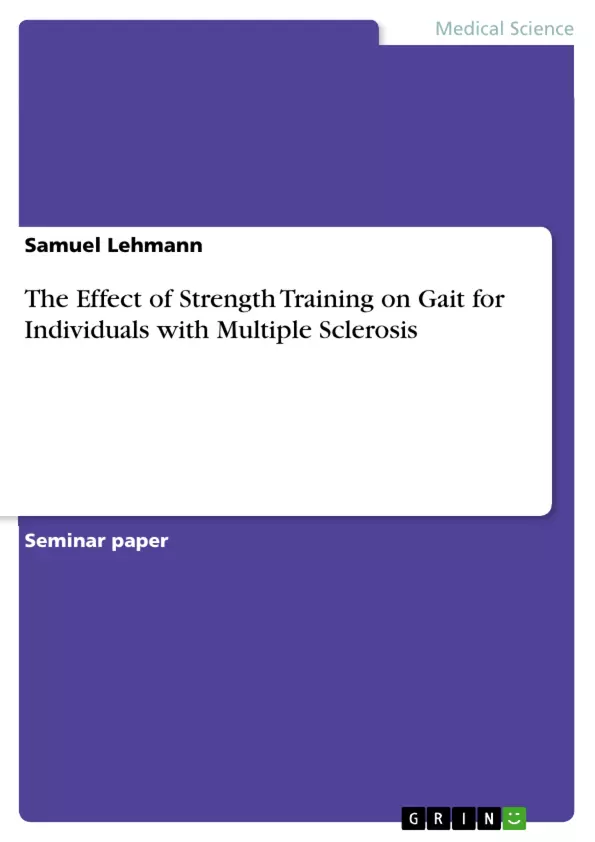Gait impairments are highly prevalent in PwMS and have been found to vary in severity and correlate with deterioration of muscle strength. Hence, ST has been regarded as a promising avenue for PwMS although its effectiveness in promoting improvements in gait were unsubstantiated. The purpose of this review was to explore and evaluate the literature surrounding the effectiveness of ST in improving gait in PwMS. Following the analysis of four studies, ST could not be confirmed as effective in improving gait; as was the case in the works of Brændvik et al., (2015) Callesen et al., (2019) and Dodd et al., (2011), although outcome measure disparities and ST intervention selections were identified as potential factors influencing the findings. However, an alternate approach utilised by Manca et al. (2020) in carrying out DST of the ankle dorsiflexors saw significant improvements in gait speed and quality. When considering the lack of supporting evidence uncovered, it can be concluded that moderate intensity ST over a period of 6-10 weeks should not be recommended clinically for the purpose of improving gait in PwMS. Future investigations should explore the effectiveness of higher intensity, task-specific ST applied over a longer intervention period to a greater range of disability levels.
Inhaltsverzeichnis (Table of Contents)
- Introduction
- Methodology
- Study search parameters: Inclusion and exclusion criteria
- Data collection
- Results
- Discussion
- Gait outcome measures; speed, endurance and quality
- Interventions
- Sample populations and study designs
- Conclusion
- References
Zielsetzung und Themenschwerpunkte (Objectives and Key Themes)
This review aims to explore and evaluate the literature surrounding the effectiveness of strength training in improving gait in individuals with Multiple Sclerosis (PwMS). The review investigates whether strength training can effectively combat gait dysfunction caused by inactivity in PwMS and analyzes existing research on the subject. The review also examines the potential benefits of strength training in improving muscle strength and overall gait efficiency.
- The impact of strength training on gait in individuals with Multiple Sclerosis (PwMS)
- The effectiveness of strength training as a strategy to combat gait dysfunction caused by inactivity in PwMS
- The influence of strength training on muscle strength and gait efficiency in PwMS
- The evaluation of existing research on the relationship between strength training and gait in PwMS
- The exploration of different methodologies and outcomes of studies related to strength training and gait in PwMS
Zusammenfassung der Kapitel (Chapter Summaries)
The Introduction provides an overview of Multiple Sclerosis (MS) and its impact on gait. It discusses the prevalence of gait limitations in PwMS, highlighting the importance of rehabilitation approaches targeting gait restoration. The chapter also examines the historical perspective on exercise recommendations for PwMS and the evolving understanding of inactivity's role in deconditioning and lower extremity muscle weakness. The introduction concludes by emphasizing the potential of strength training as a promising strategy to combat MS gait dysfunction.
The Methodology section details the research process undertaken for this review. It outlines the search strategy, including the databases used, search terms, and inclusion/exclusion criteria applied. The chapter also describes the data collection process, encompassing the extraction and analysis of relevant information from selected studies.
Schlüsselwörter (Keywords)
This review focuses on the keywords: strength training, resistance training, gait, Multiple Sclerosis, PwMS, gait dysfunction, muscle strength, gait efficiency, deconditioning, rehabilitation, physiotherapy, functional outcomes, randomized controlled trials, case control studies, literature review.
- Arbeit zitieren
- Samuel Lehmann (Autor:in), 2020, The Effect of Strength Training on Gait for Individuals with Multiple Sclerosis, München, GRIN Verlag, https://www.hausarbeiten.de/document/903765


